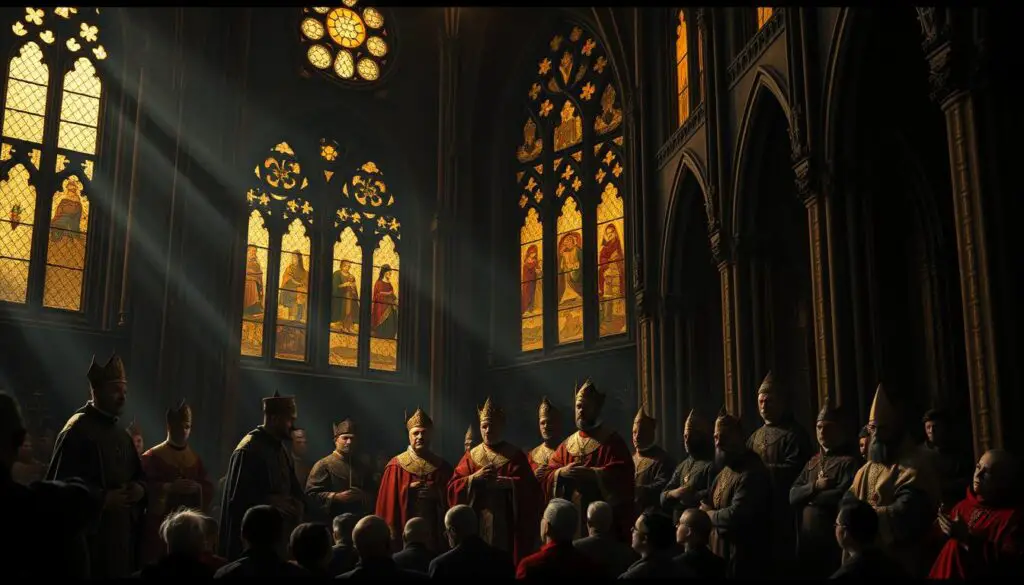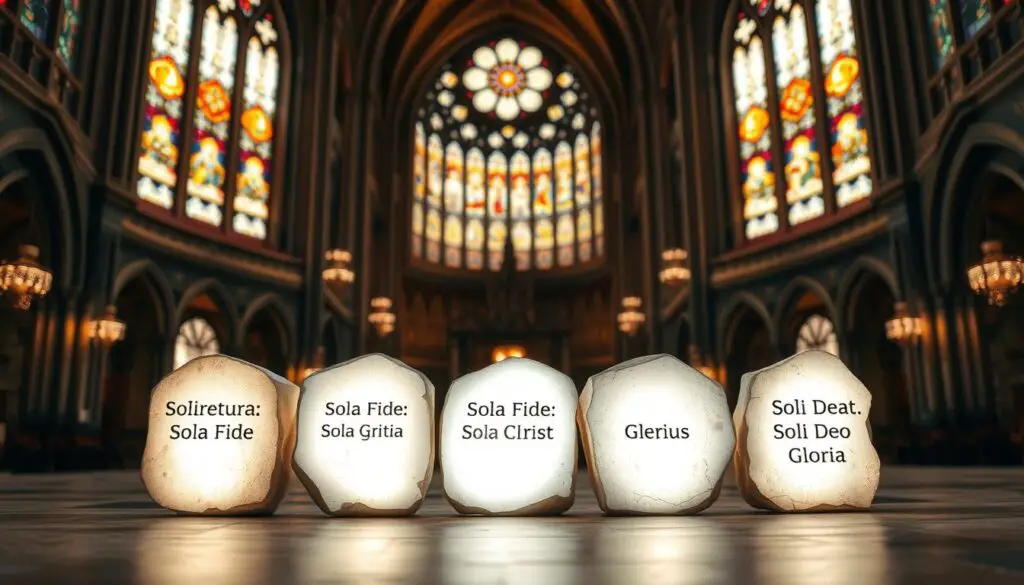In the early 1500s, a religious movement began reshaping Europe’s spiritual landscape. What started as a push for reform within the church grew into a defining chapter of Christian history. This shift didn’t just alter worship practices—it changed societies, politics, and cultures across continents.
Born from debates over doctrine and authority, this movement challenged long-standing traditions. Over time, it evolved into one of Christianity’s three main branches. While rooted in Europe, its ideas traveled far through migration and missionary work, leaving lasting marks on the modern world.
Today, its influence remains visible—especially in the United States, where it shaped education, ethics, and community values. From local churches to global networks, the movement’s legacy continues to inspire millions. Let’s explore how this pivotal era began and why its effects still matter.
Key Takeaways
- Began in 16th-century Europe as a reform effort within Christianity
- Grew into one of the three major branches of the faith worldwide
- Sparkled debates over religious authority and practices
- Spread globally through colonization and cultural exchange
- Shaped modern concepts of individualism and education
- Remains influential in American religious and social life
Introduction to Protestantism
The term “Protestant” first entered history books through a bold political act. In 1529, German princes protested restrictions on Martin Luther’s teachings at the Second Diet of Speyer. This defiant stand gave the movement its name and marked a turning point in Christian history.
Defining the Movement and Its Roots
At its core, this religious shift challenged Roman Catholic traditions. Leaders argued that Scripture alone—not church hierarchy—should guide faith. As one reformer declared: “The Bible needs no interpreter but the Holy Spirit.”
Three key ideas shaped early Protestant Christians:
- Salvation through faith, not deeds
- Personal Bible study over priestly instruction
- Direct relationship with God
Contextual Overview and Historical Timeline
The movement spread rapidly after 1529, branching into different groups. While all shared core doctrines, interpretations varied. This diversity became a hallmark of Protestant identity.
By 1600, nearly half of Europe’s Christian church communities had broken from Roman Catholic authority. The word “Protestant” now described everyone from Lutherans to Calvinists—all united by their revolutionary approach to faith.
The Historical Context of the Late Medieval Church
Europe’s 15th-century Catholic Church buzzed with contradictions. While many sought deeper spiritual life, others in power treated faith like a marketplace. This tension set the stage for seismic changes in Christian practice.

Medieval Critiques and Reform Impulses
Long before Luther’s protests, calls for change echoed through the Roman Catholic Church. A Spanish bishop once lamented: “Gold flows to Rome while souls wither in poverty.” Reformers targeted three main issues:
- Church leaders living like royalty
- Selling blessings and forgiveness for profit
- Neglecting religious education
Two popes became symbols of excess. Innocent VIII hosted weddings for his children at the Vatican. Alexander VI bought his position and fathered eight children. Such scandals made many question the church’s authority.
The Role of the Catholic Church and European Society
Kings and citizens grew tired of Rome’s demands. When the Roman Catholic Church funded wars and art through heavy taxes, farmers and traders felt the pinch. A 1492 record shows:
| Church Expense | Cost Equivalent | Funded By |
|---|---|---|
| St. Peter’s Basilica | $950 million today | Indulgence sales |
| Papal armies | 20% of annual income | Local dioceses |
| Cardinals’ palaces | 300 peasant lifetimes | Tithes |
Yet amid the turmoil, ordinary people found meaning. Visiting saints‘ shrines brought comfort, even as some clergy exploited these traditions. This mix of faith and frustration would soon reshape a continent.
Seeds of Reformation: Pre-Protestant Movements
Long before Luther’s protests, bold figures planted ideas that would shake Christendom. These pioneers worked within medieval Catholicism while challenging its flaws—their writings and actions created fertile ground for change.
The Legacy of Early Reformers and Critics
Four trailblazers stand out in this pre-reform era:
- William of Ockham argued ordinary believers could correct church errors
- John Wycliffe translated the Bible into English, declaring: “Scripture alone guides true faith”
- Jan Hus condemned corrupt clergy while leading Prague’s university
- Lorenzo Valla proved the Donation of Constantine—a key papal power claim—was forged
Christian humanists added fuel to the fire. Desiderius Erasmus mocked empty rituals through satirical teachings, urging focus on Christ’s original message. His 1516 Greek New Testament became a reformer’s handbook.
These efforts created lasting change. When Hus was burned in 1415, followers formed Europe’s first non-Catholic church. Wycliffe’s Bible translations spread for 100 years before Luther’s German edition.
“The highest form of devotion is to restore the church to its original purity.”
Through scholarship and courage, these reformers showed freedom of thought could reshape religious beliefs. Their work made later reforms not just possible—but inevitable.
The Protestant Reformation and Key Figures
The 16th century witnessed a religious earthquake that reshaped Christianity. At its epicenter stood bold thinkers who dared question centuries-old traditions. Their ideas sparked debates in town squares and royal courts alike.
Martin Luther’s Seminal Impact
In 1517, Martin Luther nailed his Ninety-Five Theses to a church door—an act that lit the fuse of change. This German monk rejected the “salvation for sale” practice of indulgences, declaring: “True repentance flows from the heart, not a coin purse.”
His 1521 stand at the Diet of Worms became legendary. When ordered to recant, Luther refused: “My conscience is captive to God’s Word. Here I stand.” This defiance birthed a new Christian tradition rooted in:
- Scripture as ultimate authority
- Salvation through faith alone
- Priesthood of all believers
Other Reformers: Calvin, Zwingli, and Wycliffe
While Luther shook Germany, John Calvin organized Protestant thought in Switzerland. His concept of predestination—“God elects those He will save”—became central to Reformed churches. Across the Alps, Huldrych Zwingli argued for simpler worship services, clashing with Luther over communion’s meaning.
The 1529 Diet of Speyer proved pivotal. When princes protested Charles V’s crackdown on reforms, they coined the term “Protestant.” This political stand ensured Luther’s ideas would spread beyond Wittenberg.
“The church must be born again through Scripture’s pure spring.”
Together, these protestant reformers created a spiritual revolution. Their emphasis on personal faith and biblical study still shapes millions of believers worldwide.
The Evolution and Diversification of Protestantism
New branches of Christian practice blossomed like wildflowers after spring rain. As reformers’ ideas spread, regional cultures and local needs shaped distinct denominations. From Scandinavian Lutherans to Dutch Reformed communities, each group blended core principles with unique traditions.

Emergence of Denominations and Regional Variations
Local languages and customs transformed worship styles. German congregations sang hymns with pipe organs, while Scottish Presbyterians favored unaccompanied psalms. Three factors drove this diversity:
- Cultural adaptation of protestant theology
- Political alliances with regional rulers
- Different interpretations of Scripture
Baptists emerged emphasizing adult baptism. Methodists organized small-group discipleship. Yet all agreed on one revolutionary idea: “The Bible belongs to every believer.”
Doctrinal Shifts and the Five Solae
Five Latin phrases became the movement’s compass. The five solae—sola scriptura (Scripture alone) and sola fide (faith alone) being most famous—anchored doctrines across denominations. A Reformed pastor once explained: “These principles prevent us from drifting into old errors.”
This focus reshaped Christian practices. Most groups kept just two sacraments—baptism and communion—viewing them as symbols rather than magical acts. The table below shows key differences:
| Aspect | Protestant View | Catholic View |
|---|---|---|
| Sacraments | 2 | 7 |
| Salvation | Faith alone | Faith + Works |
| Authority | Scripture | Church + Scripture |
Through these changes, the movement maintained unity in essentials while allowing freedom in non-core beliefs. This balance helped protestant theology adapt across continents—and centuries.
Impact of Protestantism on Modern American Society
America’s cultural DNA carries a distinct spiritual imprint. Twelve of the original colonies planted Protestant values that still grow in modern institutions. Today, nearly half the American population identifies with this tradition—the world’s largest Protestant community.
Political, Social, and Cultural Influences
Protestant ideals shaped America’s love for education and self-governance. Early colonists built schools to teach Bible reading, creating a literate society. Many churches later led movements for civil rights and community aid programs.
Modern Denominational Landscape in the U.S.
The Southern Baptist Convention leads as America’s largest single Protestant group. But diversity thrives—from Lutheran denominations rooted in immigrant heritage to vibrant Pentecostal congregations. Over 40% of the American population now belongs to hundreds of distinct denominations.
Newer nondenominational churches adapt ancient truths for modern seekers. This flexibility helps Protestantism remain relevant while honoring its revolutionary origins. Today‘s landscape proves faith traditions can evolve without losing their core identity.
FAQ
How did Protestantism begin?
The movement emerged in the 16th century as reformers like Martin Luther challenged Roman Catholic teachings. Luther’s 95 Theses in 1517 sparked debates over practices like indulgences, leading to a split from the Catholic Church.
What role did Martin Luther play in the Reformation?
Luther’s writings, such as his emphasis on faith alone for salvation, reshaped Christian theology. His translation of the Bible into German made scripture accessible, empowering individuals to interpret teachings without relying solely on clergy.
How did John Calvin influence Protestant beliefs?
Calvin’s teachings on predestination and church governance shaped Reformed theology. His work in Geneva created a model for communities prioritizing strict moral codes and education, impacting denominations like Presbyterians and Puritans.
What are the Five Solae?
These core doctrines include Sola Scriptura (Scripture alone) and Sola Fide (faith alone). They emphasize reliance on the Bible, grace, and Christ’s sacrifice, rejecting Catholic traditions like papal authority.
How did the Reformation affect politics in Europe?
Rulers like German princes used the movement to gain independence from the Holy Roman Empire. Conflicts over religion, such as the Thirty Years’ War, reshaped borders and fueled nationalism.
What Protestant denominations are prominent in the U.S. today?
The Southern Baptist Convention, United Methodist Church, and Lutheran bodies like the ELCA are major groups. Evangelical movements and nondenominational churches also reflect ongoing diversification.
Did earlier reformers inspire Luther and Calvin?
Yes! Figures like Jan Hus and John Wycliffe critiqued church corruption and authority centuries earlier. Their calls for reform laid groundwork for the 16th-century Reformation.
How does Protestantism differ from Catholicism today?
Key differences include views on papal authority, salvation through faith vs. works, and the role of saints. Many Protestant services focus on preaching, while Catholic Mass centers on sacraments like the Eucharist.